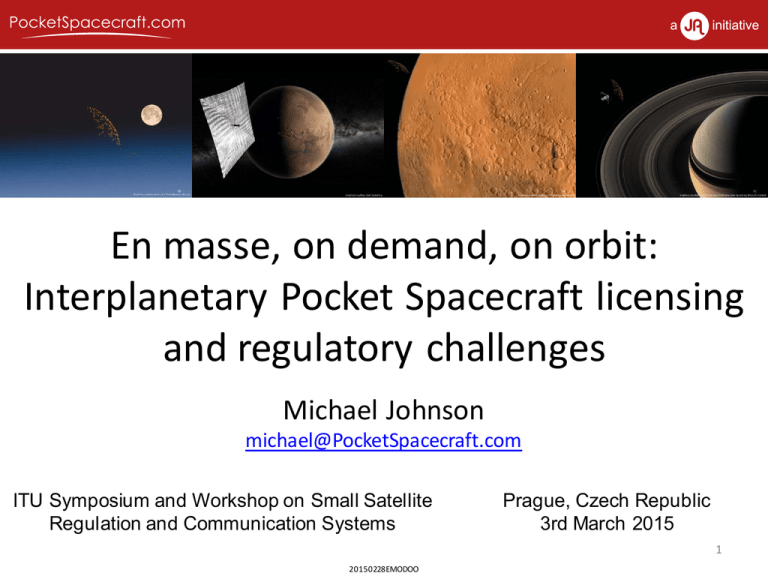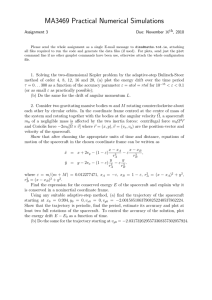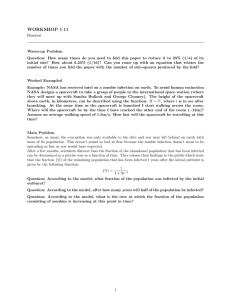En masse, on demand, on orbit: Interplanetary Pocket Spacecraft licensing Michael Johnson
advertisement

En masse, on demand, on orbit: Interplanetary Pocket Spacecraft licensing and regulatory challenges Michael Johnson michael@PocketSpacecraft.com ITU Symposium and Workshop on Small Satellite Regulation and Communication Systems Prague, Czech Republic 3rd March 2015 1 20150228EMODOO About JA • Founded 2010 • Ops in China, IoM, UK & USA • Creates, encourages, funds, manages or otherwise supports more than two dozen open source open access space exploration infrastructure projects • Seven flight projects • Collaborate with academia, enthusiasts, government, industry and non-profits • >300 volunteers, >30 countries 20150228EMODOO 2 goal send spacecraft to orbit and/or land on the surface of every body in the solar system over the next 25 21.1 years 3 20150228EMODOO goal send spacecraft to orbit and/or land on the surface of every body in the solar system over the next 25 21.1 years >101 > ~ 5000km radius >102 > ~ 100 km radius >104 > ~ 20 km radius >106 > ~ 0.5km radius in asteroid belt alone 4 20150228EMODOO Graphics courtesy: Alan Taylor, kokogiak.com The Solution? pocket spacecraft a spacecraft that an individual can afford to buy, launch and operate with little or no technical expertise personal space age the era of exploration of space by private individuals for science, general interest and profit 5 20150228EMODOO Graphics courtesy: JA / PocketSpacecraft.com Modular Interplanetary Mission Architecture • science goals • be useful, be responsible • work within existing frameworks and systems where possible • enable many of the >95% of missions not down selected • consumer goals • support 106 participating explorers • video game size quantum of exploration • instant gratification and mass customisation • appeal to everyone from collectors to citizen space engineers • easy to use for everyone • point and click/touch design, collaboration and autonomous operation • sustainable • fun, interactive, immersive for years or decades • spread risk, be comfortable not knowing where it may lead • legal, honest, decent and truthful • make affordable - crowd source, fractionate and automate everything • symbiotic and respectful • scientists need explorers, explorers need scientists • everyone needs engineers 6 • all skill levels can contribute something – apps/money both ways 20150228EMODOO KickSat mission • Crowd sourced funding via 315 KickStarter backers – – – – – – 67 @ $25 67 @ $75 88 @ $300 26 @ $1000 0 @ $5000 1 @ $10000 • NASA ELaNa 5 launch April 2014 • Student labour • Reuse existing open source systems • Very inexpensive • Very short lived 7 20150228EMODOO 7 Graphics: KickStarter.com, Wikimedia Citizen Explorers 8 20150228EMODOO Photos courtesy: JA / OpenMissionControl.org 9 20150228EMODOO Graphics courtesy: JA / PocketSpacecraft.com Graphics courtesy: JA, Matt Bennett-JPL Resistance: – – – – – – – – ‘They will never work’ ‘You can’t do anything useful’ ‘They are just for students’ ‘You can’t do real science’ ’You can’t fit real instruments’ ‘You can’t do useful imaging with such small apertures’ ‘They don’t have enough power’ ‘They’re unreliable’ “It’s hard to imagine [ChipSats and TF-SLRs] will be capable enough, but that’s exactly what people said about CubeSats.” Therese Moretto Jorgensen, Program Director, National Science Foundation Nature 508, 300-301 (17 April 2014) 10 20150228EMODOO Graphics: M. Santer, Imperial College London Resistance: – – – – – – – – ‘They will never work’ ‘You can’t do anything useful’ ‘They are just for students’ ‘You can’t do real science’ ’You can’t fit real instruments’ ‘You can’t do useful imaging with such small apertures’ ‘They don’t have enough power’ ‘They’re unreliable’ “It’s hard to imagine [ChipSats and TF-SLRs] will be capable enough, but that’s exactly what people said about CubeSats.” Therese Moretto Jorgensen, Program Director, National Science Foundation Nature 508, 300-301 (17 April 2014) 11 20150228EMODOO Graphics: M. Santer, Imperial College London Communications and navigation 20150228EMODOO Graphics courtesy: ASTRON, JA, LuxSpace, STFC Challenges – generic / speculative / mixed missions • Purpose may not be known at launch • Spacecraft can be launched speculatively • Potential clashes with existing frameworks (e.g. amateur vs scientific vs commercial) • Design to deployment can be minutes 20150228EMODOO Graphics courtesy:JA, M.Travis - YouTube Challenges – number of spacecraft • 3881 payloads catalogued on orbit by U.S. Space Surveillance Network • KickSat proof of concept low earth orbit mission launched 2014: 2500 >100 spacecraft 2000 • Pocket Spacecraft interplanetary proof of concept mission 2015/16: 1500 1000 >1000 spacecraft 500 • Potentially >1 million TF-SLRs to 0 come over next two decades • Number of spacecraft printed per mothership may be unknown at launch and could vary by orders of magnitude 20002002200420062008201020121014 20150228EMODOO Graphics: Ben Bishop, JA Challenges – economics • Current regulatory fees for spacecraft that can profitably be manufactured, launched and operated for less than $99 each can be disproportionate (>$10,000 per spacecraft) • License application fee (no guarantee of success): UK: £6,500- £13,000 per mission (£0 in China, Spain, USA, etc.) • €60 million third party insurance cover per mission: UK: €600,000 per year indefinitely (£0 in China, Spain, USA, etc.) 20150228EMODOO Graphics: UKSA Challenges – international and fluid ownership • Pocket Spacecraft interplanetary proof of concept mission has spacecraft backed by participants from >40 countries • Spacecraft could be designed, manufactured, launched, deployed, managed or operated by different children and adults with multiple citizenships with ownership changing at every step and over time 20150228EMODOO Graphics: Twitter Questions? * michael@PocketSpacecraft.com * if your question is about an open source project: - no restrictions * if your question is about a closed source project and we’re at JPL: - please be aware that there is no export license for this activity. This visit request is approved by I/ECO provided that no export controlled technical data or technical assistance related to a spacecraft or its systems / subsystems will be provided by JPL. All export controlled technical data in office areas that the visitor(s) is to visit must be removed from sight either behind closed doors that will not be visited or in closed files. All discussions, presentations, and/or information released to the foreign visitor must not contain export controlled technical data. Information released must be limited to general descriptions and information already published in the public domain. Technical discussions must not disclose design, development, production, manufacture, assembly, operation, repair, testing, maintenance or modification of any defense articles (e.g. spacecraft or instrument). Escorted areas where access is granted to the foreign visitor(s) may not contain exposed export controlled technical information. Please contact I/ECO if further guidance is desired. 20150228EMODOO 17 Graphics courtesy: iCubeSat.org




